
The genus Aesculus, with species called buckeye and horse chestnut, comprises 13–19 species of flowering plants in the family Sapindaceae. They are trees and shrubs native to the temperate Northern Hemisphere, with six species native to North America and seven to 13 species native to Eurasia. Several hybrids occur. Aesculus exhibits a classical Arcto-Tertiary distribution.
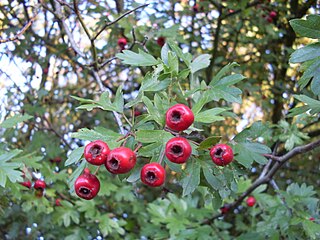
Crataegus monogyna, known as common hawthorn, one-seed hawthorn, or single-seeded hawthorn, is a species of flowering plant in the rose family Rosaceae. It is native to Europe, northwestern Africa, and West Asia, but has been introduced in many other parts of the world.

Althaea officinalis, the marsh mallow or marshmallow, is a species of flowering plant indigenous to Europe, Western Asia and North Africa, which is used in herbalism and as an ornamental plant. A confection made from the root since ancient Egyptian times evolved into today's marshmallow treat, but most modern marshmallow treats no longer contain any marsh-mallow root.
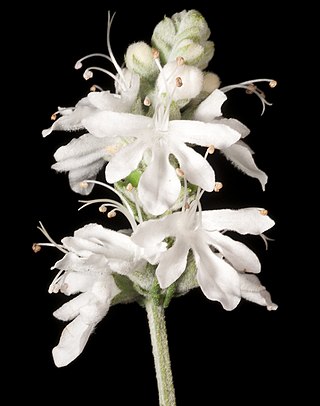
Teucrium is a cosmopolitan genus of flowering plants in the family Lamiaceae, commonly known as germanders. Plants in this genus are perennial herbs or shrubs, with branches that are more or less square in cross-section, leaves arranged in opposite pairs, and flowers arranged in thyrses, the corolla with mostly white to cream-coloured, lobed petals.

The stigma is the receptive tip of a carpel, or of several fused carpels, in the gynoecium of a flower.
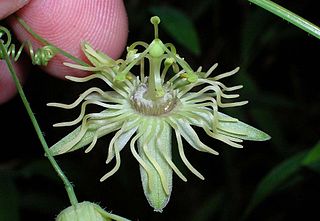
Passiflora lutea, commonly known as yellow passionflower, is a flowering perennial vine in the family Passifloraceae, native to the central and eastern United States. The vine has three-lobed leaves and small, yellowish-green, fringed flowers that appear in the summer, followed by green fruit that turn almost black at maturity. It grows in moist to wet habitats.

Astartea is a genus of flowering plants in the myrtle family, Myrtaceae. The genus is endemic to southwestern Western Australia. The genus name was inspired by Astarte, the Greek name for the goddess Ishtar.
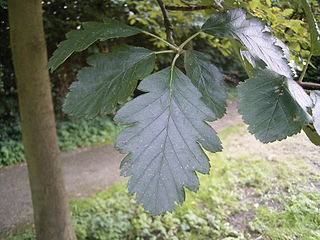
Scandosorbus intermedia or, formerly, Sorbus intermedia, the Swedish whitebeam, is a species of whitebeam found in southern Sweden, with scattered occurrences in Estonia, Latvia, easternmost Denmark (Bornholm), the far southwest of Finland, and northern Poland.

Euphorbia misera is a semi-succulent shrub in the genus Euphorbia commonly known as the cliff spurge or coast spurge. A drought-deciduous shrub, it is typically found as a gnarled, straggly plant occupying seashore bluffs, hills and deserts. Like other members of its genus, it has a milky sap, which can be found exuding out of the light gray bark when damaged. The alternately-arranged leaves are round and folded in the middle, with small hairs on them. The "flowers" can be found blooming year-round, and are colored maroon or yellow in the center with 5 white to light-yellow petal-like appendages attached outside. This species is native to the Baja California peninsula and Sonora in Mexico, and the coast of southern California in the United States, where it is a rare species. It is threatened in some localities by the development of its coastal habitat, which tends to be prime locations for high-end residential and commercial developments.

Succisa pratensis, also known as devil's-bit or devil's-bit scabious, is a flowering plant in the honeysuckle family Caprifoliaceae. It differs from other similar species in that it has four-lobed flowers, whereas small scabious and field scabious have five lobes and hence it has been placed in a separate genus in the same family. It also grows on damper ground.
This glossary of botanical terms is a list of definitions of terms and concepts relevant to botany and plants in general. Terms of plant morphology are included here as well as at the more specific Glossary of plant morphology and Glossary of leaf morphology. For other related terms, see Glossary of phytopathology, Glossary of lichen terms, and List of Latin and Greek words commonly used in systematic names.

Calochortus amabilis is a species of the genus Calochortus in the family Liliaceae. It is also known by the common names Diogenes' lantern, yellow globe-tulip, golden globe-tulip, yellow globe lily, golden fairy lantern, golden lily-bell, Chinese lantern, and short lily.
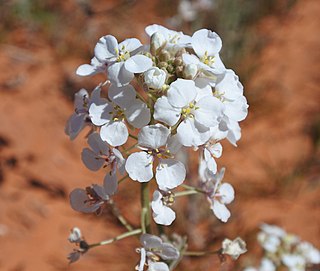
Dimorphocarpa wislizeni, commonly known as spectacle pod, Wislizeni's spectaclepod, and touristplant, is a flowering plant in the mustard family native to western North America, where it occurs in the southwestern United States as far east as Oklahoma and Texas, and Baja California, Sonora, Chihuahua, and Coahuila in Mexico.

California macrophylla, commonly known as roundleaf stork's bill, is a species of flowering plant in the geranium family, Geraniaceae. It was formerly placed in the genus Erodium, but was later placed in a monotypic genus of its own named California.

Rapistrum rugosum is a species of flowering plant in the mustard family known by the common names annual bastardcabbage, common giant mustard or turnipweed. It is native to Eurasia and parts of Africa, and it is present throughout the world as an introduced species and a common weed. It is an invasive species in many areas. It is an annual herb producing an erect stem reaching up to about a meter tall. The leaves are variable in shape and size and the proximal blades are generally cut into lobes or divided into leaflets. The herbage is coated in rough hairs. The inflorescence is a raceme of flowers with dark-veined yellow petals that are each under a centimeter long. The fruit is a knoblike spherical ribbed silique borne on a long pedicel with a widened area where it joins the fruit.

Ceanothus herbaceus, also known as Jersey tea, is a species of shrub in the family Rhamnaceae and is similar to Ceanothus americanus and Ceanothus sanguineus. It is a perennial shrub which is native to North America.

Strophostyles helvola, commonly called amberique-bean, annual sand bean, or trailing fuzzybean is a species of flowering plant in the legume family. It is native to eastern Canada and the eastern United States.

Balduina uniflora, commonly called oneflower honeycombhead, savannah honeycombhead or oneflower balduina, is a North American species of plants in the sunflower family. It is native to the southeastern United States. It is the type species of the genus Balduina.

Strasburgeria robusta is an evergreen tree with large toothed leaves and large but rather inconspicuous, single, pendulant flowers in a gloomy colorscheme of yellowish with brown markings, with about ten sepals, five petals, ten stamens, a very distinct circular nectar gland with radiating spikes and rather large globular fruits with a long persistent style, with a scent reminiscent of apples, which is endemic to New Caledonia. It is the only recognized species of the genus Strasburgeria.
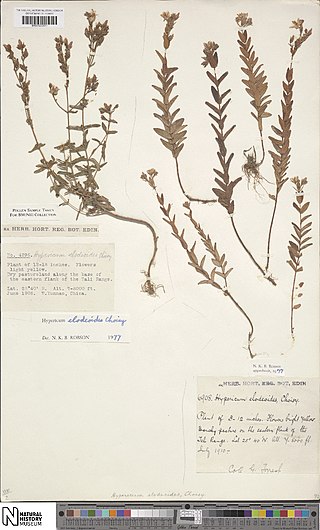
Hypericum elodeoides, commonly called the Himalayan St. John's Wort, is a species of flowering plant of the St. John's wort family (Hypericaceae).



















